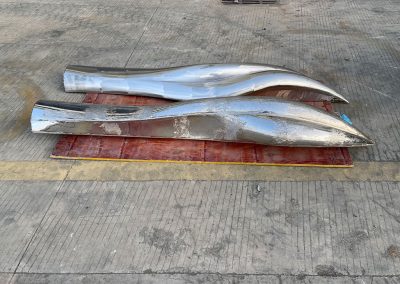He has an old Pine Bluff Forge anvil. It’s a blacksmith anvil with a horn for shaping horseshoes. It also has three holes called “hardie holes.” He uses the heck out of two of the holes for shaping.
To shape, you pound with your hammer where the anvil isn’t. By pounding over a hole you can make a bowl, a dish, a curve, a shape.
Kevin takes a small piece of 16 gauge steel and hammers the end of it over one of the hardie holes. Before long, the metal is curved across and is also startng to curve front to back. So you can do a lot of shaping as well as pound something flat.
Speaking of flattening, Kevin takes the the scrap metal and hammers it on the anvil. You can hear a ringing, which indicates that the flat part of the steel is right against the face of anvil so all the force of the hammer is getting transferred to the anvil itself.
When Kevin hammers the curved part against the anvil, the ring is gone. As he continues to hammer, though, you can hear the ring return, which means the piece is flat again.
Kevin emphasizes that you don’t have to wail on the metal or beat the crap out of it. Choke up on the hammer and let the weight of the hammer do the work.
You can shape pretty thick metal, too. Kevin has shaped 1/8″ plate and even 1/4″ plate, although his arm almost fell off after that because he used a good-sized hammer. The thicker the metal, the bigger force you need behind it to get your work done, so the bigger the hammer.
Usually, if the metal is more than 1/8″, he’ll heat it in the forge or get out the rosebud for his oxygen-acetylene unit. When the metal is hot, you can work pretty gently tap it to shape it the way you want.
The anvil is great for more complex shapes, things he can’t do with the air shaper or the English wheel.
The real use for those hardie holes is for, well, hardies. Kevin shows a hardy with different radii that fits in the forge he has outside to use with his coal forge. It’s for shaping. You can take your red-hot metal out of your forge and work it any way you want.
The same thingis true for the horn: it can be used for shaping, too. There’s a flat surface that gets more rounded, a more rounded area on both sides, and that rather sharp point on the horn – watch where you’re going around that!
Kevin made the stand for the anvil, which weighs about 150 pounds. The top is 1/2″ steel plate, with a quarter-inch wall square tubing and then a harrow dish underneath it for a base. The square tubing is full of sand to help deaden the noise and help keep it stable. He added hooks all around the top of the base for his hammers, pliers, tongs for the forge, etc.
An anvil is really old school, but Kevin uses the heck out of it. If you have a chance to pick up an anvil, do it. You’ll find all kind of uses for it.
And when it’s been a really bad day, you can always grab a piece of 1/2″ plate and wale on it with a hammer for the fun of it.
Speaking of waling, hang around for another moment to see him take out his frustrations …..

